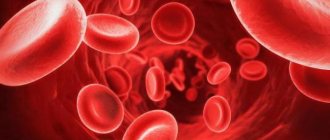- What function do lymphocytes perform?
- Types of lymphocytosis
- Physiological lymphocytosis
- Lymphocytosis in viral diseases
- Lymphocytosis in bacterial infections
- Hematological diseases
- Endocrine system diseases
- Rheumatological, allergic and parasitic diseases
- Diagnosis of lymphocytosis
- Treatment of lymphocytosis
Lymphocytosis is a type of leukocytosis.
This is a condition in which the level of lymphocytes in the blood of an adult exceeds 4000 units, and in children under 5 years of age - 6000 units per microliter. In percentage terms, this ranges from 40% or more for adults and 55% for young children. Normally, the blood of a healthy adult contains 20-40% lymphocytes. Lymphocytosis can occur for physiological and pathological reasons. As a rule, in most cases it is one of the symptoms of the disease. The cause of lymphocytosis can be not only blood diseases, but also viruses, infections, and certain physiological reactions.
To diagnose lymphocytosis, venous or capillary blood is used. Laboratory testing determines the main blood parameters, including the level of lymphocytes.
What function do lymphocytes perform?
These blood cells provide the body's defense against pathogens. Lymphocytes produce immunoglobulins - antibodies that bind to viral infection and thereby prevent it from entering the cells of organs and tissues. Lymphocytes are also part of the mechanism to destroy cells that are already infected with the virus. In a similar way, lymphocytes can fight certain types of bacterial and parasitic infections. Thus, an increase in lymphocytes in the blood is the response of the immune system when an infection enters the body.
Types of lymphocytosis
The disease is divided into relative and absolute types. Relative is characterized by an increase in the number of lymphocytes against the background of normal or reduced levels of leukocytes in the blood.
With absolute lymphocytosis, the level of lymphocytes is exceeded, as is the content of leukocytes.
According to the degree of excess, moderate and high lymphocytosis are distinguished. If the percentage of lymphocytes is below 60%, we are talking about moderate lymphocytosis. When the lymphocyte content is high, it is above 60%, which may be a sign of a malignant hematological disease or diseases of the lymphatic system.
Physiological lymphocytosis
Sometimes an increase in lymphocytes is not associated with a disease and is a natural reaction of the body. The main reasons for this phenomenon are:
- early childhood;
- psycho-emotional stress;
- fasting, avoidance of animal products;
- taking certain medications.
In children under 4-5 years of age, an increased level of lymphocytes is a physiological norm. Already from the first week of life in a newborn, the lymphocyte count reaches 55-60%. This is due to age-related characteristics of the immune system. By 4-5 years, the level of lymphocytes decreases to 40%. If in a small child this figure exceeds 60%, this is a pathology.
As for lymphocytosis during stress, fasting, and taking medications, the change in the leukocyte formula is short-term. The indicators return to normal as soon as the causative factor ceases to affect the body.
What determines the degree of lymphocyte enlargement?
According to popular belief, the severity of the disease can be judged by how much the patient’s tests are changed. In some cases this is true. For example, the severity of jaundice is determined by the content of bilirubin in the blood (the more it is, the more serious the situation), and by the erythrocyte sedimentation rate - the degree of activity of rheumatic diseases. But with lymphocytes everything is not so simple. For example, with the same viral infection they can be normal, elevated, and sometimes it even happens that with ARVI, lymphocytes are reduced.
It is also appropriate to remember that there is such a thing as hyperimmunity. In this case, in response to the slightest irritation, for example to a slight viral runny nose, a huge number of lymphocytes are produced, and the test results terrify the attending physician, who immediately begins to suspect the person has lymphocytic leukemia. But in fact, the nature of such changes is only that the patient’s immunity reacts strongly to any threat.
In general, if a person has elevated lymphocytes, the reasons for this should be determined not by their number, but by their general health, symptoms, data from other studies, and the results of a conversation with a doctor.
If the doctor identifies any disease, the patient needs to follow the proposed treatment regimen in order to quickly bring the level of lymphocytes and general health back to normal. To achieve faster and better results, it is recommended to take Transfer Factor.
– a special tool created on the basis of information molecules. It has a universal training effect on the immune system and normalizes its functioning, regardless of what exactly the person is sick with. Taking the drug gives positive results in the treatment of most diseases.
Lymphocytosis in viral diseases
Diseases caused by viruses are a common cause of lymphocytosis. In adults, it occurs with influenza and acute respiratory infections. In children - with chickenpox, measles, rubella. As a rule, patients are diagnosed with moderate lymphocytosis, which occurs as the symptoms of the disease increase. After recovery, blood counts return to normal.
The exception is infectious mononucleosis caused by the Epstein-Barr virus. The pathogen belongs to the herpevirus family. It multiplies in B lymphocytes and stimulates their growth. Adults and children are susceptible to this disease, but in childhood the risk of getting sick is much higher. In middle-aged and mature people, the pathology occurs without pronounced symptoms, since specific immunity has already been formed.
Against the background of infectious mononucleosis, persistent moderate lymphocytosis is observed. In addition, atypical mononuclear cells are found in the blood - large cells characteristic of the disease.
Lymphocytosis in bacterial infections
Some diseases caused by pathogenic bacteria also result in lymphocytosis. As a rule, we are talking about diseases that have a chronic course. In adults, lymphocytosis is diagnosed against the background of tuberculosis, syphilis, brucellosis, and various forms of typhoid diseases. In children, a similar condition is observed with whooping cough.
Changes in leukocyte counts depend on the nature of the pathology. In the chronic form, there may be a slight or moderate increase in levels that persists for several months or even years. If the disease worsens, the number of lymphocytes increases as symptoms increase.
Causes of lymphocytosis
The causes of lymphocytosis may be the following:
- Stressful conditions, surges in hormone levels in the body. In addition, physical activity and menstrual bleeding in a woman can cause an increase in the level of lymphocytes. This lymphocytosis is temporary and goes away on its own.
- Tobacco smoking for many years. If a person suffers from this addiction, then his lymphocyte level may remain consistently high. In parallel, erythrocytosis is observed.
- Infectious diseases affecting the body by viruses, bacteria or parasites. At the same time, the immune system is quickly activated. If the infection is bacterial in nature, then the level of neutrophils in the blood increases, and with a viral infection the number of lymphocytes increases. Therefore, any viral infection is accompanied by lymphocytosis. This indicates the activation of the body’s defenses and its active resistance to the disease. The level of lymphocytes will remain elevated until recovery occurs. Lymphocytosis can result from mononucleosis, whooping cough, tuberculosis, syphilis and some other chronic bacterial infections.
- Blood cancer: chronic lymphocytic leukemia and acute lymphoblastic leukemia. When the bone marrow is damaged, immature lymphoblasts are formed in it, which do not have the ability to become full-fledged lymphocytes. These cells are unable to form normal immunity, so the person begins to suffer from various infections. Moreover, he will be seriously ill and for a long time. Acute lymphoblastic leukemia most often develops in childhood; in adults, the pathology is less common. In chronic lymphocytic leukemia, the number of mature lymphocytes in the bone marrow increases, but they are unable to perform their functions.
- Thyrotoxicosis. Lymphocytes take part in the body's immune reactions, which occur in a slow manner. Therefore, an increase in their number in the blood may indicate autoimmune processes. Thyrotoxicosis is one of the most striking examples of such a disorder. In addition, other autoimmune processes can be accompanied by lymphocytosis: Crohn's disease, rheumatoid arthritis, etc.
- Intoxication of the body with lead, arsenic or carbon disulfide. In case of poisoning, relative lymphocytosis is observed, at this time it is important to monitor the level of neutrophils in order to prevent a sharp drop in immunity.
- Treatment with a number of medications. Lymphocytosis can be caused by taking drugs such as: Levomycetin, Levodopa, Phenytoin, Valproic acid, and some analgesics.
- Splenectomy. Removing the spleen is an operation that can be performed in a hospital only for certain indications. Its absence in the body can provoke a temporary increase in the level of lymphocytes in the blood. Then the internal systems adapt and blood counts return to normal.
Hematological diseases
High lymphocytosis is observed in diseases of the hematopoietic system and lymphatic tissue. Malignant diseases cause proliferation - uncontrolled cell division and tissue growth. In myeloproliferative and lymphoproliferative diseases, a corresponding change in cells in the bone marrow occurs.
The most common hematopoietic diseases that cause lymphocytosis are lymphosarcoma, lymphogranulomatosis, and chronic leukemia. Lymphocyte counts in such pathologies can reach 70-90%. Growth occurs gradually, reaching a maximum several years after the onset of the disease. To treat lymphocytosis, it is necessary to address the underlying cause that led to an increase in the number of lymphocytes. Chemotherapy courses and bone marrow transplants help bring lymphocyte counts back to normal.
In addition to malignant diseases of the hematopoietic system, lymphocytosis occurs against the background of anemia caused by deficiency of vitamin B12 and folic acid. In patients who have undergone blood transfusion, an increase in the number of lymphocytes may appear as one of the signs of post-transfusion syndrome.
Endocrine system diseases
Diseases that are accompanied by impaired hormonal secretion also cause lymphocytosis. What causes this reaction has not yet been precisely established. A moderate increase in lymphocytes is observed in acromegaly, a pathology that is accompanied by an increase in the production of growth hormone by the pituitary gland.
Thyrotoxicosis - excess secretion of thyroid hormones - can also lead to lymphocytosis. The same is observed in patients with adrenal insufficiency. In children with congenital dysfunction of the gonads, an increase in the number of lymphocytes is observed.
In all of these cases, the condition can be corrected by prescribing hormonal therapy.
Rheumatological, allergic and parasitic diseases
In patients with systemic lupus erythematosus, rheumatoid arthritis, and rheumatic fever, there is a change in the leukocyte blood count towards an increase in the number of lymphocytes.
Allergy sufferers and patients with bronchial asthma also experience a similar condition.
When infected with schistosomiasis, a parasitic infection caused by helminths of the genus Schistosoma, the level of lymphocytes increases against the background of damage to internal organs. The most rare causes of lymphocytosis include tropical infections: malaria and Chagas disease. The carriers of such infections are insects; infection occurs through a bite. In our country, travelers who visit countries in Latin America, Africa, and the states of the Western Pacific are at risk of contracting such diseases.
Diagnosis of lymphocytosis
A clinical blood test helps to identify excess lymphocytes. An adult patient can go to a medical laboratory for an examination, or make an appointment with a general practitioner or therapist. Children are advised to visit a pediatrician.
Since lymphocytosis is not a separate disease, but a symptom of disorders, the doctor collects anamnesis and suggests undergoing a comprehensive diagnosis. It includes:
- Blood analysis. He determines the leukocyte formula to identify the ratio of all types of leukocytes, determine the indicators of ESR, CRP. The biomaterial is examined for the presence of atypical mononuclear cells. If cancer of the hematopoietic system is suspected, diagnostics are performed to identify tumor antigens.
- Special studies to identify the pathogen. To normalize blood counts during an infectious disease, you need to know the exact cause of lymphocytosis. To do this, the doctor collects anamnesis and, taking into account the existing symptoms, prescribes examinations. The PRC method is used to detect antibodies to viruses. If tuberculosis and whooping cough are suspected, a microbiological examination of sputum is performed. Serological diagnosis helps identify brucellosis.
- Hardware and instrumental diagnostics. Patients with lymphocytosis are prescribed hardware and instrumental studies. If tuberculosis is suspected, an x-ray of the lungs is required, which will show the lesions and help assess its extent. For mononucleosis and hematological malignancies, an abdominal ultrasound is prescribed. Patients with this disease exhibit pathological enlargement of the spleen and, in some cases, the liver.
- Histology. For leukemia, lymphomas and other dangerous pathologies, patients require a histological examination of the bone marrow. It will show the presence of altered blood cells and help assess the type of pathology. A puncture is performed to obtain biomaterial.
Symptoms of lymphocytosis
Lymphocytosis is not an independent pathology, but only a consequence of any disorders or changes in the body. Therefore, the symptoms of an increase in the level of lymphocytes in the blood will be determined by the symptoms of the underlying disease.
With viral infections, fever, sore throat, intestinal disorders, skin rashes, etc. come to the fore. In addition to lymphocytosis, the patient will also experience other abnormalities in blood counts.
With tumors of the hematopoietic tissue, patients experience pain in the bones, and the body temperature will remain elevated all the time. Bleeding increases, immunity decreases.
With lymphocytosis and neutropenia, there is a high probability of a viral infection, such as whooping cough, ARVI, diphtheria, sepsis, etc. With lymphocytosis and monocytopenia, it makes sense to suspect measles, chickenpox, mumps. If monocytes and lymphocytes are significantly higher than normal, the patient should be tested for monocytic leukemia or myelodysplastic syndrome.
With infectious mononucleosis, the patient experiences an increase in body temperature, a sore throat, lymph nodes increase in size, and increased weakness and sweating, especially at night. The disease is caused by the Epstein-Barr virus.
Serious poisoning and bacterial infections contribute to an increase in the absolute and relative level of lymphocytes. At the same time, the jump can be quite impressive.
Chronic lymphocytosis, which persists in a person over a long period of time, may be a sign of a sluggish infection, immunodeficiency, or a developing cancer. As a rule, the immunity of such patients is reduced, they get sick for a long time and often, and suffer from constant weakness. Body temperature may remain at subfebrile levels.
At the same time, a long-term slight increase in the level of lymphocytes in healthy people is possible. Experts do not rule out that this may be due to the individual characteristics of the body.
Lymphocytosis in a child
After the birth of a child, he will have increased levels of neutrophils in the blood. Around the 10th day of life, the level of lymphocytes begins to increase, their percentage occupies about 60% of all blood cells. A similar picture will be observed until 5-7 years. In the future, the values of lymphocytes will return to normal and approach similar indicators in an adult. Therefore, lymphocytosis in a young child is a normal variant and is not a pathological sign.
Most often, the child’s body reacts to any infection with a significant jump in the level of lymphocytes. Moreover, other blood cells will remain within normal limits. Leukocytosis can be caused by chickenpox, measles, mononucleosis, influenza, rubella and other infectious diseases. After they are eliminated, the level of lymphocytes will return to its age norm. If this does not happen, or lymphocytosis persists for a long time, it makes sense to undergo a comprehensive examination.
Treatment of lymphocytosis
If the increase in the number of lymphocytes is caused by physiological reasons, no treatment is required. A pathological change in the leukocyte formula of the blood, which is accompanied by prolonged lymphocytosis, requires attention from a doctor.
There are no special drugs or techniques to normalize the lymphocyte count. The doctor’s task is to identify the cause of the pathology and eliminate it. Conservative and surgical methods can be used for treatment. For example, for chickenpox, rubella, ARVI and influenza, symptomatic therapy is prescribed: antipyretic and anti-inflammatory drugs. The patient is advised to drink plenty of fluids and gargle. Antiviral drugs are effective in the first days when flu symptoms appear.
Bacterial infections are treated with antibiotics. Lymphocytosis in tuberculosis can be eliminated if you undergo a course of treatment with drugs chosen by your doctor.
Long-term and complex therapy is required for high lymphocytosis in patients with leukemia and other diseases of the hematopoietic system. First of all, chemotherapy is prescribed, which is carried out in courses. If it does not lead to improvement, a bone marrow transplant is recommended.
Correction
There are no direct ways to normalize the concentration of lymphocytes. To combat lymphocytosis, it is necessary to treat the underlying pathology that caused the increase in lymphocytes. Minor short-term lymphocytosis that occurs due to stress, taking medications, or during recovery from a cold does not require therapy. In case of long-term lymphocytosis, both absolute and relative, you should consult a doctor.
For many viral infections (varicella, rubella, ARVI), no etiotropic therapy has been developed to date. For their treatment, pathogenetic and symptomatic methods are used - plenty of hot drinks, antipyretic, anti-inflammatory drugs. For catarrhal syndrome, gargling and irrigating the throat with antiseptic solutions and sprays are prescribed. In the first days of influenza, the use of antiviral drugs (oseltamivir, rimantadine) is effective.
There is evidence of a reduction in the number of complications of infectious mononucleosis in adults by prescribing acyclovir and valciclovir. For bacterial infections, antibiotics are prescribed, for tuberculosis, a combination of anti-tuberculosis drugs. If the cause of lymphocytosis is a lymphoproliferative disease, then long repeated courses of chemotherapy are required. If conservative treatment of chronic myeloid leukemia in adults is ineffective, allogeneic bone marrow transplantation is used.











